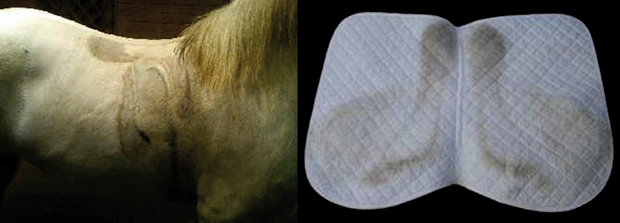Why do we see a sweat pattern where the saddle sits? The horse’s back actually has only a few sweat glands. Most of them are along his sides, at the neck or flank- areas that have a broad open surface to allow the natural influence of air and wind to cool the body with the help of sweat. This is why the large saddle flaps are called sweat flaps.
Horses are able to sweat under the saddle when friction and air circulation are present. Therefore, no sweat will form in the areas that are in constant contact (without movement) with the horse’s back. Most of the friction occurs at the front (pommel area) and back (cantle area) of the saddle. The centre of the saddle has constant pressure and the least amount of movement. There is no real amount of friction under the stirrup bars or at the gullet plate at the withers; this is the area where the horse will sweat least – and last.
 Left: Sweat marks occur in areas where there is friction and air circulation. Right: Similar to a collar on a white shirt, most of the dirt occurs where there is the most access to air circulation and friction. Here we see an excellent dust pattern on a saddle pad [from a correctly fitted saddle].
Left: Sweat marks occur in areas where there is friction and air circulation. Right: Similar to a collar on a white shirt, most of the dirt occurs where there is the most access to air circulation and friction. Here we see an excellent dust pattern on a saddle pad [from a correctly fitted saddle].Large kidney shaped (6-8” long) dry spots are acceptable under the stirrup bar, but dry spots found on the saddle support area that have a circumference of around an inch could indicate points of concentrated pressure which need to be investigated.
The sweat pattern also depends on the season, the coat length, where and how the horse is stabled, his breed, overall health and condition, and how he is ridden. If your horse’s sweat pattern is different than the first 2 images below, in a saddle which is correctly fitted, it would be advisable to contact a Certified Equine Ergonomist to identify pressures points, saddle fit issues and make recommendations for achieving optimal fit.
 These sweat marks come from damaged sweat glands caused by inappropriate girthing and an incorrect billet system.
These sweat marks come from damaged sweat glands caused by inappropriate girthing and an incorrect billet system.
Jochen Schleese is author of ‘Suffering in Silence – The Saddle fit Link to Physical and Psychological Trauma in Horses’ (2013). Through the Saddlefit 4 Life global network of equine professionals Jochen Schleese provides industry education to help equestrians recognize and prevent saddle fit issues and long term damage to horse and rider. Find answers in a personal 80 point Saddle Fit Evaluation to horse and rider.
www.SaddlesforWomen.comand Guys too! 1-800-225-2242 www.Saddlefit4life.com





